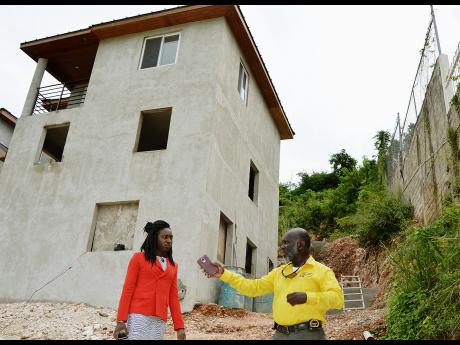Growth & Jobs | Contractor Sees Good Prospects Ahead
Mark Anthony Johnson helps Jamaicans to build their dream homes, and he says that business has never been better.
He started Jerimarc Designs & Construction Company in 1990, doing underground tank installation in the bauxite and petroleum industries, prior to switching his focus, as changes in those industries limited his opportunities. He maintains that shifting to residential construction was one of the smartest decisions he has ever made.
"I interpret what my clients say they want, and, therefore, I can design and build their ideal home based on their concept," he said. "That is my passion; that is my business, and I enjoy doing it 300 per cent."
Moving from heavy industrial construction to building family homes led him to complete several architectural courses overseas. The additional training gave him the ability to guide clients from the point where they consider how to best use a site to the practical execution of their dreams in concrete.
"It is satisfying to see a house grow from its foundation," he said. "It is similar to watching a seed you planted grow and flourish."
The Jamaican economic environment is facilitating many more such seeds to flourish now.
The Survey of Consumer and Business Confidence for the third quarter of 2017, conducted by Market Research Limited, indicated an improvement in consumer confidence, linked to an expansion of business and job opportunities, which has triggered the increase in home-purchasing plans.
The focus of Johnson's operations is in Kingston, St Andrew, and St Catherine, and he explained that in these parishes, he has seen a boom in the overall construction industry.
"Business conditions are improving, and people can find more money now than five years ago," he says. "Therefore, residential construction is picking up."
HELPFUL INNOVATIONS
Two innovations are helping him cope with the growing industry. One is the use of Concrete Insulated Panels (CIP), and the other is the use of the form system.
Having an insulated core that is sandwiched by cement, the Bureau of Standards-approved CIP boards can be used in exterior walls, roofs, and floor systems. Produced at the Free Form Factory in St Catherine, they are assembled and finished on site.
Using a form system involves erecting temporary or permanent moulds into which concrete is poured around steel reinforcement, Johnson said. It produces a building frame with both structural strength and elegance, to which the CIP elements can be fixed.
"Applying these systems cuts waste and requires less manpower than using building blocks," he said. "The resulting structures are hurricane and earthquake resistant, as well as offering better heat and sound insulation than traditional concrete structures.
"We can build your house faster, more cost effectively, and better than before with these methodologies," he said. "Quality assurance has improved, and the overall construction process is easier."
Shortage of skilled workers remains problematic
There are two long-standing challenges remaining in the construction sector.
"There is a shortage of skilled workers," Johnson states. "Fewer skilled workers have more difficulty interpreting the instructions accurately, and, therefore, are less able to execute their job properly.
"Many of the young workers entering the field don't have the required skills," the contractor stated. "That means when you find good employees, you do your best to keep them."
His other major challenge is helping to ensure that clients understand the cost implications of design changes.
"Building a house is the biggest investment decision most people will make in their lives," he says. "They effectively become chief executive officers and spend large sums of money."
He explained: "The challenge during a project comes when a client wants to change the house plan. And every additional foot in the construction of a house costs an extra $100,000 as floors, walls and ceilings are adjusted. Requests from clients for changes are common and represent a major risk for the contractor as the budget for a structure is often set beforehand."
Graduating from St Andrew Technical High School and ultimately going on to do an architectural programme in the United States provided the academic basis for Johnson to build his small business over three decades. Currently, he has core team of five permanent employees and an additional 18 workers on contract across three projects.
He maintains that access to finance has been critical to the long-term development of Jerimarc Designs, which is why he has come to appreciate doing business with JN Bank.
Saniah Spencer, chief of marketing at JN Bank, says that the construction sector is one of the most important components in the economy, and its success helps the country to reduce its deficit of buildings and infrastructure, as well as being a vital source of employment.


